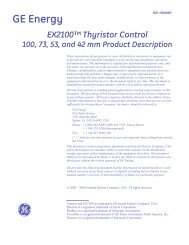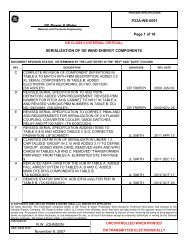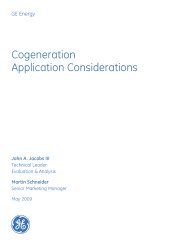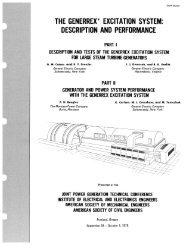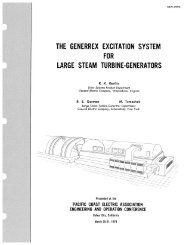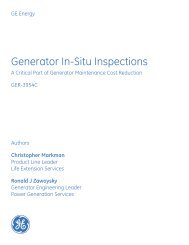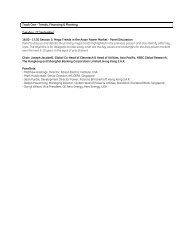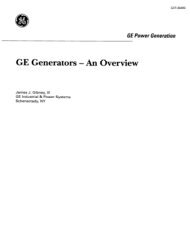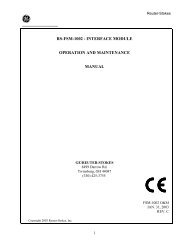GER 3568G - Dry Low NOx Combustion Systems for ... - GE Energy
GER 3568G - Dry Low NOx Combustion Systems for ... - GE Energy
GER 3568G - Dry Low NOx Combustion Systems for ... - GE Energy
You also want an ePaper? Increase the reach of your titles
YUMPU automatically turns print PDFs into web optimized ePapers that Google loves.
<strong>Dry</strong> <strong>Low</strong> NO x <strong>Combustion</strong> <strong>Systems</strong> <strong>for</strong> <strong>GE</strong> Heavy-Duty Gas Turbines<br />
The spark plug and flame detector arrangements<br />
in a DLN-1 combustor are different from<br />
those used in a conventional combustor. Since<br />
the first stage must be re-ignited at high load in<br />
order to transfer from the premixed mode back<br />
to lean-lean operation, the spark plugs do not<br />
retract. One plug is mounted near a primary<br />
zone cup in each of two combustors. The system<br />
uses flame detectors to view the primary stage of<br />
selected chambers (similar to conventional systems),<br />
and secondary flame detectors that look<br />
through the centerbody and into the second<br />
stage.<br />
The primary fuel injection system is used during<br />
ignition and part load operation. The system<br />
also injects most of the fuel during premixed<br />
operation and must be capable of stabilizing<br />
the flame. For this reason, the DLN-1 primary<br />
fuel nozzle is similar to <strong>GE</strong>’s MS7001EA<br />
multi-nozzle combustor with multiple swirl-stabilized<br />
fuel injectors. The <strong>GE</strong> DLN-1 system<br />
uses five primary fuel nozzles <strong>for</strong> the MS6001B<br />
and smaller machines and six primary fuel nozzles<br />
<strong>for</strong> the larger machines. This design is capable<br />
of providing a well-stabilized diffusion flame<br />
that burns efficiently at ignition and during<br />
part load operation.<br />
In addition, the multi-nozzle fuel injection system<br />
provides a satisfactory spatial distribution<br />
of fuel flow entering the first-stage mixer. The<br />
primary fuel-air mixing section is bound by the<br />
combustor first-stage wall, the cap/centerbody<br />
and the <strong>for</strong>ward cone of the venturi. This volume<br />
serves as a combustion zone when the<br />
combustor operates in the primary and leanlean<br />
modes. Since ignition occurs in this stage,<br />
crossfire tubes are installed to propagate flame<br />
and to balance pressures between adjacent<br />
chambers. Film slots on the liner walls provide<br />
cooling, as they do in a standard combustor.<br />
In order to achieve good emissions per<strong>for</strong>m-<br />
ance in premixed operation, the fuel-air equivalence<br />
ratio of the mixture exiting the first-stage<br />
mixer must be very lean. Efficient and stable<br />
burning in the second stage is achieved by providing<br />
continuous ignition sources at both the<br />
inner and outer surfaces of this flow. The three<br />
elements of this stage comprise a piloting flame,<br />
an associated aerodynamic device to <strong>for</strong>ce interaction<br />
between the pilot flame and the inner<br />
surface of the main stage flow, and an aerodynamic<br />
device to create a stable flame zone on<br />
the outer surface of the main stage flow exiting<br />
the first stage.<br />
The piloting flame is generated by the secondary<br />
fuel nozzle, which premixes a portion of the<br />
natural gas fuel and air (nominally, 17% at fullload<br />
operation) and injects the mixture<br />
through a swirler into a cup where it is burned.<br />
Burning an even smaller amount of fuel (less<br />
than 2% of the total fuel flow) stabilizes this<br />
flame as a diffusion flame in the cup. The secondary<br />
nozzle, which is mounted in the cap<br />
centerbody, is simple and highly effective <strong>for</strong><br />
creating a stable flame.<br />
A swirler mounted on the downstream end of<br />
the cap/centerbody surrounds the secondary<br />
nozzle. This creates a swirling flow that stirs the<br />
interface region between the piloting flame and<br />
the main-stage flow and ensures that the flame<br />
is continuously propagated from the pilot to the<br />
inner surface of the fuel-air mixture exiting the<br />
first stage. Operation on oil fuel is similar<br />
except that all of the secondary oil is burned in<br />
a diffusion flame in the current dry oil design.<br />
The sudden expansion at the throat of the venturi<br />
creates a toroidal re-circulation zone over<br />
the downstream conical surface of the venturi.<br />
This zone, which entrains a portion of the venturi<br />
cooling air, is a stable burning zone that<br />
acts as an ignition source <strong>for</strong> the main stage<br />
fuel-air mixture. The cone angle and axial loca-<br />
<strong>GE</strong> Power <strong>Systems</strong> ■ <strong><strong>GE</strong>R</strong>-<strong>3568G</strong> ■ (10/00) 5



